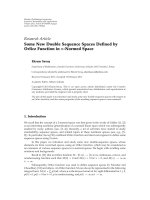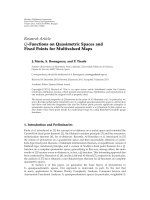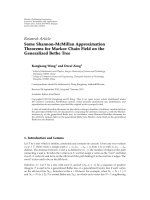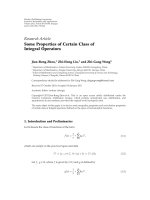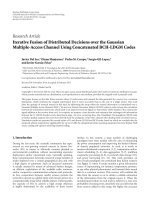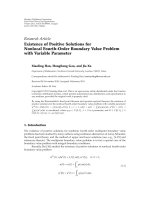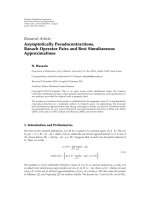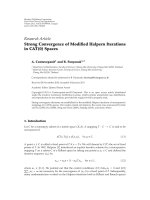báo cáo hóa học:" Research Article Some Krasnonsel’ski˘-Mann Algorithms and ı the Multiple-Set Split Feasibility Problem" doc
Bạn đang xem bản rút gọn của tài liệu. Xem và tải ngay bản đầy đủ của tài liệu tại đây (508.83 KB, 12 trang )
Hindawi Publishing Corporation
Fixed Point Theory and Applications
Volume 2010, Article ID 513956, 12 pages
doi:10.1155/2010/513956
Research Article
Some Krasnonsel’ski
˘
ı-Mann Algorithms and
the Multiple-Set Split Feasibility Problem
Huimin He,
1
Sanyang Liu,
1
and Muhammad Aslam Noor
2, 3
1
Department of Mathematics, Xidian University, Xi’an 710071, China
2
Mathematics Department, COMSATS Institute of Information Technology, Islamabad, Pakistan
3
Mathematics Department, College of Science, King Saud University, Riyadh 11451, Saudi Arabia
Correspondence should be addressed to Huimin He,
Received 3 April 2010; Revised 7 July 2010; Accepted 13 July 2010
Academic Editor: S. Reich
Copyright q 2010 Huimin He et al. This is an open access article distributed under the Creative
Commons Attribution License, which permits unrestricted use, distribution, and reproduction in
any medium, provided the original work is properly cited.
Some variable Krasnonsel’ski
˘
ı-Mann iteration algorithms generate some sequences {x
n
}, {y
n
},
and {z
n
}, respectively, via the formula x
n1
1 − α
n
x
n
α
n
T
N
···T
2
T
1
x
n
, y
n1
1 − β
n
y
n
β
n
N
i1
λ
i
T
i
y
n
, z
n1
1 − γ
n1
z
n
γ
n1
T
n1
z
n
,whereT
n
T
n modN
and the mod function
takes values in {1, 2, ,N}, {α
n
}, {β
n
},and{γ
n
} are sequences in 0, 1, and {T
1
,T
2
, ,T
N
} are
sequences of nonexpansive mappings. We will show, in a fairly general Banach space, that the
sequence {x
n
}, {y
n
}, {z
n
} generated by the above formulas converge weakly to the common
fixed point of {T
1
,T
2
, ,T
N
}, respectively. These results are used to solve the multiple-set split
feasibility problem recently introduced by Censor et al. 2005. The purpose of this paper is to
introduce convergence theorems of some variable Krasnonsel’ski
˘
ı-Mann iteration algorithms in
Banach space and their applications which solve the multiple-set split feasibility problem.
1. Introduction
The Krasnonsel’ski
˘
ı-Mann K-M iteration algorithm 1, 2 is used to solve a fixed point
equation
Tx x, 1.1
where T is a self-mapping of closed convex subset C of a Banach space X. The K-M algorithm
generates a sequence {x
n
} according to the recursive formula
x
n1
1 − α
n
x
n
α
n
Tx
n
, 1.2
2 Fixed Point Theory and Applications
where {α
n
} is a sequence in the interval 0, 1 and the initial guess x
0
∈ C is chosen arbitrarily.
It is known 3 that if X is a uniformly convex Banach space with a Frechet differentiable norm
in particular, a Hilbert space,ifT : C → C is nonexpansive, that is, T satisfies the property
Tx − Ty
≤
x − y
∀x, y ∈ C 1.3
and if T has a fixed point, then the sequence {x
n
} generated by the K-M algorithm 1.2
converges weakly to a fixed point of T provided that {α
n
} fulfils the condition
∞
n0
α
n
1 − α
n
∞.
1.4
See 4, 5 for details on the fixed point theory for nonexpansive mappings.
Many problems can be formulated as a fi xed point equation 1.1 with a nonexpansive
T and thus K-M algorithm 1.2 applies. For instance, the split feasibility problem SFP
introduced in 6–8, which is to find a point
x ∈ C such that Ax ∈ Q, 1.5
where C and Q are closed convex subsets of Hilbert spaces H
1
and H
2
, respectively, and A is
a linear bounded operator from H
1
to H
2
. This problem plays an important role in the study
of signal processing and image reconstruction. Assuming that the SFP 1.5 is consistent i.e.,
1.5 has a solution, it is not hard to see that x ∈ C solves 1.5 if and only if it solves the
fixed point equation
x P
C
I − γA
∗
I − P
Q
A
x, x ∈ C, 1.6
where P
C
and P
Q
are the orthogonal projections onto C and Q, respectively, γ>0isany
positive constant and A
∗
denotes the adjoint of A. Moreover, for sufficiently small γ>0, the
operator P
C
I − γA
∗
I − P
Q
A which defines the fixed point equation 1.6 is nonexpansive.
To solve the SFP 1.5, Byrne 7, 8 proposed his CQ algorithm see also 9 which
generates a sequence {x
n
} by
x
n1
P
C
I − γA
∗
I − P
Q
A
x
n
,n≥ 0, 1.7
where γ ∈ 0, 2/λ with λ being the spectral radius of the operator A
∗
A. In 2005, Zhao and
Yang 10 considered the following perturbed algorithm:
x
n1
1 − α
n
x
n
α
n
P
C
n
I − γA
∗
I − P
Q
n
A
x
n
, 1.8
where C
n
and Q
n
are sequences of closed and convex subsets of H
1
and H
2
, respectively,
which are convergent to C and Q, respectively, in the sense of Mosco c.f. 11. Motivated
Fixed Point Theory and Applications 3
by 1.8, Zhao and Yang 10, 12 also studied the following more general algorithm which
generates a sequence {x
n
} according to the recursive formula
x
n1
1 − α
n
x
n
α
n
T
n
x
n
, 1.9
where {T
n
} is a sequence of nonexpansive mappings in a Hilbert space H, under certain
conditions, they proved convergence of 1.9 essentially in a finite-dimensional Hilbert space.
Furthermore, with regard to 1.9,Xu13 extended the results of Zhao and Yang 10 in the
framework of fairly general Banach space.
The multiple-set split feasibility problem MSSFP which finds application in
intensity-modulated radiation therapy 14 has recently been proposed in 15 and is
formulated as finding a point
x ∈ C
N
i1
C
i
such that Ax ∈ Q
M
j1
Q
j
,
1.10
where N and M are positive integers, {C
1
,C
2
, ,C
N
} and {Q
1
,Q
2
, ,Q
M
} are closed and
convex subsets of H
1
and H
2
, respectively, and A is a linear bounded operator from H
1
to
H
2
.
Assuming consistency of the MSSFP 1.10, Censor et al. 15 introduced the following
projection algorithm:
x
n1
P
Ω
⎛
⎝
x
n
− γ
⎛
⎝
N
i1
α
i
x
n
− P
C
i
x
n
M
j1
β
j
A
∗
Ax
n
− P
Q
j
Ax
n
⎞
⎠
⎞
⎠
, 1.11
where Ω is another closed and convex subset of H
1
,0 <γ<2/L with L
N
i1
α
i
ρA
∗
A
M
j1
β
j
and ρA
∗
A being the spectral radius of A
∗
A,andα
i
> 0 for all i and β
j
> 0
for all j. They studied convergence of the algorithm 1.11 in the case where both H
1
and H
2
are finite dimensional. In 2006, Xu 13 demonstrated some projection algorithms for solving
the MSSFP 1.10 in Hilbert space as follows:
x
n1
P
C
N
I − γ∇q
···
P
C
1
I − γ∇q
x
n
,n≥ 0,
y
n1
N
i1
λ
i
P
C
i
⎛
⎝
y
n
− γ
M
j1
β
j
A
∗
I − P
Q
j
Ay
n
⎞
⎠
,n≥ 0,
z
n1
P
C
n1
⎛
⎝
z
n
− γ
M
j1
β
j
A
∗
I − P
Q
j
Az
n
⎞
⎠
,n≥ 0,
1.12
where qx1/2
M
j1
β
j
P
Q
j
Ax − Ax
2
, ∇qx
M
j1
β
j
A
∗
I − P
Q
j
Ax, x ∈ C, and C
n
C
n mod N
and the mod function takes values in {1, 2, ,N}. This is a motivation for us to
4 Fixed Point Theory and Applications
study the following more general algorithm which generate the sequences {x
n
}, {y
n
},and
{z
n
}, respectively, via the formulas
x
n1
1 − α
n
x
n
α
n
T
N
···T
2
T
1
x
n
, 1.13
y
n1
1 − β
n
y
n
β
n
N
i1
λ
i
T
i
y
n
, 1.14
z
n1
1 − γ
n1
z
n
γ
n1
T
n1
z
n
, 1.15
where T
n
T
n mod N
, {α
n
}, {β
n
},and{γ
n
} are sequences in 0, 1,and{T
1
,T
2
, ,T
N
} are
sequences of nonexpansive mappings. We will show, in a fairly general Banach space X,that
the sequences {x
n
}, {y
n
},and{z
n
} generated by 1.13, 1.14,and1.15 converge weakly to
the common fixed point of {T
1
,T
2
, ,T
N
}, respectively. The applications of these results are
used to solve t he multiple-set split feasibility problem recently introduced by 15.
Note that, letting C be a nonempty subset of Banach space X and A, B are self-
mappings of C,weuseD
ρ
A, B to denote sup{Ax − Bx : x≤ρ},thatis,
D
ρ
A, B
: sup
Ax − Bx
:
x
≤ ρ
. 1.16
This paper is organized as follows. In the next section, we will prove a weak
convergence theorems for the three variable K-M algorithms 1.13, 1.14,and1.15 in a
uniformly convex Banach space with a Frechet differentiable norm the class of such Banach
spaces include Hilbert space and L
p
and l
p
space for 1 <p<∞. In the last section, we
will present the applications of the weak convergence theorems for the three variable K-M
algorithms 1.13, 1.14,and1.15.
2. Convergence of Variable Krasnonsel’ski
˘
ı-Mann Iteration Algorithm
To solve the multiple-set split feasibility problem MSSFP in Section 3, we firstly present
some theorems of the general variable Krasnonsel’ski
˘
ı-Mann iteration algorithms.
Theorem 2.1. Let X be a uniformly convex Banach space with a Frechet differentiable norm, let C
be a nonempty closed and convex subset of X, and let T
i
: C → C be nonexpansive mapping, i
1, 2, ,N. Assume that the set of common fixed point of {T
1
,T
2
, ,T
N
},
N
i1
FixT
i
, is nonempty.
Let {x
n
} be any sequence generated by 1.13 ,where0 <α
n
< 1 satisfy the conditions
i
∞
n0
α
n
1 − α
n
∞;
ii
∞
n0
α
n
D
ρ
T
N
···T
1
,T
i
< ∞ for every ρ>0 and i 1, 2, ,N,whereD
ρ
T
N
···T
1
,
T
i
sup{T
N
···T
1
x − T
i
x : x≤ρ}.
Then {x
n
} converges weakly to a common fixed point p of {T
1
,T
2
, ,T
N
}.
Fixed Point Theory and Applications 5
Proof. Since T
i
: C → C is nonexpansive mapping, for i 1, 2, ,N, then, the composition
T
N
···T
2
T
1
is nonexpansive mapping from C to C.LetU : T
N
···T
2
T
1
.
Take x ∈
N
j1
FixT
j
x ∈ FixU to deduce that
x
n1
− x
≤
1 − α
n
x
n
− x
α
n
Ux
n
− x
≤
x
n
− x
.
2.1
Thus, {x
n
− x} is a decreasing sequence, and we have that lim
n →∞
x
n
− x exists. Hence,
{x
n
} is bounded, so are {T
i
x
n
}, i 1, 2, ,N,and{Ux
n
}.Letρ sup{x
n
, Ux
n
− T
i
x
n
:
n ≥ 0,i 1, 2, ,N} < ∞, and let r 2ρ x < ∞.
Now since X is uniformly convex, by 16, Theorem 2, there exists a continuous strictly
convex function ϕ,withϕ00, so that
λx
1 − λ
y
2
≤ λ
x
2
1 − λ
y
2
− λ
1 − λ
ϕ
x − y
,
2.2
for all x, y ∈ X such that x≤r and y≤r and for all λ ∈ 0, 1.LetUx
n
− T
i
x
n
, i
1, 2, ,N, be replaced by e
n,i
note that e
n,i
≤D
ρ
U, T
i
, and taking a constant M so that
M ≥ sup{2x
n
− x α
n
e
n,i
: n ≥ 0}, by the above 2.2,weobtainthat
x
n1
− x
2
1 − α
n
x
n
− x α
n
e
n,i
α
n
T
i
x
n
− x α
n
e
n,i
2
≤
1 − α
n
x
n
− x α
n
e
n,i
2
α
n
T
i
x
n
− x α
n
e
n,i
2
− α
n
1 − α
n
ϕ
x
n
− T
i
x
n
≤
1 − α
n
x
n
− x
2
2α
n
x
n
− x
e
n,i
α
2
n
e
n,i
2
α
n
T
i
x
n
− x
2
2α
n
e
n,i
T
i
x
n
− x
α
2
n
e
n,i
2
− α
n
1 − α
n
ϕ
x
n
− T
i
x
n
≤
x
n
− x
2
Mα
n
D
ρ
U, T
i
− α
n
1 − α
n
ϕ
x
n
− T
i
x
n
.
2.3
It follows that
α
n
1 − α
n
ϕ
x
n
− T
i
x
n
≤
x
n
− x
2
−
x
n1
− x
2
Mα
n
D
ρ
U, T
i
.
2.4
Since lim
n →∞
x
n
− x exists, by condition ii and 2.4, it implies that
∞
n1
α
n
1 − α
n
ϕ
x
n
− T
i
y
n
< ∞
2.5
6 Fixed Point Theory and Applications
which further implies that by i lim inf
n →∞
ϕx
n
− T
i
x
n
0, hence,
lim inf
n →∞
x
n
− T
i
x
n
0.
2.6
On the other hand, it is not hard to deduce from 1.13 that
x
n1
− T
i
x
n1
1 − α
n
x
n
α
n
Ux
n
− T
i
x
n1
1 − α
n
x
n
α
n
Ux
n
− T
i
x
n
T
i
x
n
− T
i
x
n1
≤
1 − α
n
x
n
− T
i
x
n
α
n
Ux
n
− T
i
x
n
x
n1
− x
n
1 − α
n
x
n
− T
i
x
n
α
n
Ux
n
− T
i
x
n
α
n
x
n
− Ux
n
≤
1 − α
n
x
n
− T
i
x
n
α
n
Ux
n
− T
i
x
n
α
n
x
n
− T
i
x
n
α
n
T
i
x
n
− Ux
n
x
n
− T
i
x
n
2α
n
Ux
n
− T
i
x
n
≤
x
n
− T
i
x
n
2α
n
D
ρ
T
i
,U
.
2.7
Since
∞
n1
α
n
D
ρ
U, T
i
< ∞, we see that lim
n →∞
x
n
− T
i
x
n
exists. This together with 2.6
implies that
lim
n →∞
x
n
− T
i
x
n
0.
2.8
The demiclosedness principle for nonexpansive mappings see 5, 17 implies that
ω
w
x
n
⊂
N
i1
F
T
i
,
2.9
where ω
w
x
n
{x : ∃x
n
j
x} denotes the weak ω-limit set of {x
n
}.
To prove that {x
n
} is weakly convergent to a common fixed point p of {T
1
,T
2
, ,T
N
},
it now suffices to prove that ω
w
x
n
consists of exactly one point.
Fixed Point Theory and Applications 7
Indeed, if there are
x, x ∈ ω
w
x
n
x
n
i
x, x
m
j
x, since lim
n →∞
x
n
− x and
lim
n →∞
x
n
− x exist, if x
/
x, then
lim
n →∞
x
n
− x
2
lim
j →∞
x
m
j
− x
x − x
2
lim
j →∞
x
m
j
− x
2
x − x
2
2 lim
j →∞
x
m
j
− x, x − x
lim
j →∞
x
m
j
− x
2
x − x
2
> lim
i →∞
x
m
i
− x
2
lim
i →∞
x
n
i
− x
2
lim
i →∞
x
n
i
− x
x − x
2
lim
i →∞
x
n
i
− x
2
x − x
2
2 lim
j →∞
x
n
i
− x, x − x
lim
i →∞
x
n
i
− x
2
x − x
2
> lim
i →∞
x
n
i
− x
2
lim
n
x
n
− x
2
.
2.10
This is a contradiction.
The proof is completed.
Theorem 2.2. Let X be a uniformly convex Banach space with a Frechet differentiable norm, let C
be a nonempty closed and convex subset of X, and let T
i
: C → C be nonexpansive mapping, i
1, 2, ,N, assume that the set of common fixed point of {T
1
,T
2
, ,T
N
},
N
i1
FixT
i
, is nonempty.
Let {y
n
} be defined by 1.14,where0 <β
n
< 1 satisfy the following conditions
i
∞
n0
β
n
1 − β
n
∞;
ii
∞
n0
β
n
D
ρ
N
i1
λ
i
T
i
,T
i
< ∞ for every ρ>0 and i 1, 2, ,N,where
D
ρ
N
i1
λ
i
T
i
,T
i
sup{
N
i1
λ
i
T
i
x − T
i
x : x≤ρ}.
Then {y
n
} converges weakly to a common fixed point q of {T
1
,T
2
, ,T
N
}.
Proof. Since T
i
: C → C is a nonexpansive mapping, i 1, 2, ,N, then, it is not hard to see
that
N
i1
λ
i
T
i
is a nonexpansive mapping from C to C.
The remainder of the proof is the same as Theorem 2.1.
The proof is completed.
Theorem 2.3. Let X be a uniformly convex Banach space with a Frechet differentiable norm, let C be
a nonempty closed convex subset of X, and let T
i
: C → C be nonexpansive mapping, i 1, 2, ,N,
assume that the set of common fixed point of {T
1
,T
2
, ,T
N
},
N
i1
FixT
i
, is nonempty. Let {z
n
} be
defined by 1.15,where0 <γ
n
< 1 satisfy the conditions
i
∞
n0
γ
n
1 − γ
n
∞;
ii
∞
n0
γ
n
D
ρ
T
n1
,T
i
< ∞ for every ρ>0 and i 1, 2, ,N,whereD
ρ
T
n1
,T
i
sup{T
n1
x − T
i
x : x≤ρ}.
Then {z
n
} converges weakly to a common fixed point w of {T
1
,T
2
, ,T
N
}.
8 Fixed Point Theory and Applications
Proof. Since T
n
T
n mod N
and {T
1
,T
2
, ,T
N
} is a sequence of nonexpansive mappings from
C to C, so, the proof of this theorem is similar t o Theorems 2.1 and 2.2.
The proof is completed.
3. Applications for Solving the Multiple-Set Split
Feasibility Problem (MSSFP)
Recall that a mapping T in a Hilbert space H is said to be averaged if T can be written as
1 − λI λS, where λ ∈ 0, 1 and S is nonexpansive. Recall also that an operator A in H is
said to be γ-inverse strongly monotone γ-ism for a given constant γ>0if
x − y, Ax − Ay
≥ γ
Ax − Ay
2
, ∀x, y ∈ H.
3.1
A projection P
K
of H onto a closed convex subset K is both nonexpansive and 1-ism. It is also
known that a mapping T is averaged if and only if the complement I − T is γ-ism for some
γ>1/2; see 8 for more property of averaged mappings and γ-ism.
To solve the MSSFP 1.10, Censor et al. 15 proposed the following projection
algorithm 1.11, the algorithm 1.11 involves an additional projection P
Ω
. Though the
MSSFP, 1.10 includes the SFP 1.5 as a special case, which does not reduced to 1.7,let
alone 1.8. In this section, we will propose some new projection algorithms which solve
the MSSFP 1.10 and which are the application of algorithms 1.13, 1.14,and1.15 for
solving the MSSFP. These projection algorithms can also reduce to the algorithm 1.8 when
the MSSFP 1.10 is reduced to the SFP 1.5.
The first one is a K-M type successive iteration method which produces a sequence
{x
n
} by
x
n1
1 − α
n
x
n
α
n
P
C
N
I − γ∇q
···
P
C
1
I − γ∇q
x
n
,n≥ 0. 3.2
Theorem 3.1. Assume that the MSSFP 1.10 is consistent. Let {x
n
} be the sequence generated by
the algorithm 3.2,where0 <γ<2/L with L A
2
M
j1
β
j
and 0 <α
n
< 1 satisfy the condition:
∞
n0
α
n
1 − α
n
∞.Then{x
n
} converges weakly to a solution of the MSSFP 1.10.
Proof. Let T
i
: P
C
i
I − γ∇q, i 1, 2, ,N.
Hence,
U T
N
···T
1
P
C
N
I − γ∇q
···
P
C
1
I − γ∇q
. 3.3
Since
∇q
x
M
j1
β
j
A
∗
I − P
Q
j
Ax, x ∈ C,
3.4
and I − P
Q
j
is nonexpansive, it is easy to see that ∇q is L-Lipschitzian, with L A
2
M
j1
β
j
.
Therefore, ∇q is 1/L-ism 18. This implies that for any 0 <γ<2/L, I − γ∇q is
averaged. Hence, for any closed and convex subset K of H
1
, the composite P
K
I − γ∇q is
averaged.
So U T
N
···T
1
P
C
N
I−γ∇q ···P
C
1
I−γ∇q is averaged, thus U is nonexpansive.
Fixed Point Theory and Applications 9
By the position 2.2 8, we see that the fixed point set of U,FixU, is the common fixed
point set of the averaged mappings {T
N
···T
1
}.
By Reich 3, we have {x
n
} converges weakly to a fixed point of U which is also a
common fixed point of {T
N
···T
1
} or a solution of the MSSFP 1.10.
The proof is completed.
The second algorithm is also a K-M type method which generates a sequence {y
n
} by
y
n1
1 − β
n
y
n
β
n
N
i1
λ
i
P
C
i
⎛
⎝
y
n
− γ
M
j1
β
j
A
∗
I − P
Q
j
Ay
n
⎞
⎠
,n≥ 0. 3.5
Theorem 3.2. Assume that the MSSFP 1.10 is consistent. Let {x
n
} be any sequence generated by
the algorithm 3.5,where0 <γ<2/L with L A
2
M
j1
β
j
and 0 <β
n
< 1 satisfy the condition:
∞
n0
β
n
1 − β
n
∞.Then{y
n
} converges weakly to a solution of the MSSFP 1.10.
Proof. From the proof of Theorem 3.1, it is easy to know that T
i
: P
C
i
I − γ∇q is averaged,
so, the convex combination S :
N
i1
λ
i
T
i
is also averaged.
Thus S is nonexpansive.
By Reich 3, we have {y
n
} converges weakly to a fixed point of S.
Next, we only need to prove the fixed point of S is also the common fixed point of
{T
N
···T
1
} which is the solution of the MSSFP 1.10,thatis,FixS
N
i1
FixT
i
.
Indeed, it suffices to show that
N
n1
FixT
i
⊃ Fix
N
i1
λ
i
T
i
.
Pick an arbitrary x ∈ Fix
N
i1
λ
i
T
i
,thus
N
i1
λ
i
T
i
x x. Also pick a y ∈ Fix
N
n1
T
i
,
thus T
i
y y, i 1, 2, ,N.
Write T
i
1 − β
i
I β
i
T
i
, i 1, 2, ,N with β
i
∈ 0, 1 and
T
i
is nonexpansive.
We claim that if z is such that T
i
z
/
z, then T
i
x − y < x − y, i 1, 2, ,N.
Indeed, we have
T
i
z − y
2
1 − β
i
z − y
β
i
T
i
z − y
2
1 − β
i
z − y
2
β
i
T
i
z − y
2
− β
i
1 − β
i
z −
T
i
z
2
≤
z − y
2
−
1 − β
i
z − T
i
z
2
<
z − y
2
, as
z − T
i
z
> 0.
3.6
If we can show that T
i
x x, then we are done. So assume that Tx
/
x.Nowsince
N
i1
λ
i
T
i
x
x
/
Tx, we have
x − y
N
i1
λ
i
T
i
x − y
≤
N
i1
λ
i
T
i
x − y
<
x − y
.
3.7
10 Fixed Point Theory and Applications
This is a contradiction. Therefore, we must have T
i
x x, i 1, 2, ,N,thatis,
N
n1
FixT
i
x
x.
This proof is completed.
We now apply Theorem 2.3 to solve the MSSFP 1.10. Recall that the ρ-distance
between two closed and convex subsets E
1
and E
2
of a Hilbert space H is defined by
d
ρ
E
1
,E
2
sup
x
≤ρ
{
P
E
1
x − P
E
2
x
}
.
3.8
The third method is a K-M type cyclic algorithm which produces a sequence {z
n
} in
the following manner: apply T
1
to the initial guess z
0
to get z
1
1 − γ
1
z
0
γ
1
P
C
1
z
0
−
γ
M
j1
β
j
A
∗
I − P
Q
j
Az
0
, next apply T
2
to z
1
to get z
2
1 − γ
2
z
1
γ
2
P
C
2
z
1
− γ
M
j1
β
j
A
∗
I −
P
Q
j
Az
1
, and continue this way to get z
N
1 − γ
N
z
0
γ
N
P
C
N
z
N−1
− γ
M
j1
β
j
A
∗
I −
P
Q
j
Az
N−1
; then repeat this process to get z
N1
1 − γ
N1
z
0
γ
N
P
C
1
z
N
− γ
M
j1
β
j
A
∗
I −
P
Q
j
Az
N
, and so on. Thus, the sequence {z
n
} is defined and we write it in the form
z
n1
1 − γ
n1
z
0
γ
n1
P
C
n1
⎛
⎝
z
n
− γ
M
j1
β
j
A
∗
I − P
Q
j
Az
n
⎞
⎠
,n≥ 0, 3.9
where C
n
C
n mod N
.
Theorem 3.3. Assume that the MSSFP 1.10 is consistent. Let {x
n
} be the sequence generated by
the algorithm 3.9,where0 <γ<2/L with L A
2
M
j1
β
j
and 0 <γ
n
< 1 satisfy the following
conditions:
i
∞
n0
γ
n
1 − γ
n
∞;
ii
∞
n0
γ
n
d
ρ
C
n1
,C
i
< ∞ and
∞
n0
γ
n
d
ρ
Q
n1
,Q
i
< ∞ for each ρ>0, i
1, 2, ,N.
Then {z
n
} converges weakly to a solution of the MSSFP 1.10.
Proof. From the proof of application 3.2,itiseasytoverifythatT
i
: P
C
i
I−γ∇q is averaged,
so, T
n1
: T
n1modN
is also averaged.
Thus T
n1
is nonexpansive.
The projection iteration algorithm 3.9 can also be written as
z
n1
1 − γ
n1
z
n
γ
n1
T
n1
z
n
. 3.10
Given ρ>0, let
ρ sup
max
Ax
,
x − γA
∗
I − P
Q
Ax
:
x
≤ ρ
< ∞. 3.11
Fixed Point Theory and Applications 11
We compute, for x ∈ H
1
, such that x≤ρ,
T
n1
x − T
i
x
≤
P
C
n1
x − γA
∗
I − P
Q
n1
Ax
−P
C
n1
x − γA
∗
I − P
Q
i
Ax
P
C
n1
x − γA
∗
I − P
Q
i
Ax
−P
C
i
x − γA
∗
I − P
Q
i
Ax
≤
P
C
n1
x − γA
∗
I − P
Q
i
Ax
−P
C
i
x − γA
∗
I − P
Q
i
Ax
γ
A
∗
P
Q
n1
Ax − P
Q
i
Ax
≤ d
ρ
C
n1
,C
i
γ
A
d
ρ
Q
n1
,Q
i
.
3.12
This shows that
D
ρ
T
n1
,T
i
≤ d
ρ
C
n1
,C
i
γ
A
d
ρ
Q
n1
,Q
i
. 3.13
It then follows from condition ii that
∞
n0
γ
n
D
ρ
T
n1
,T
i
≤
∞
n0
γ
n
d
ρ
C
n1
,C
i
∞
n0
γ
n
d
ρ
Q
n1
,Q
i
< ∞.
3.14
Now we cam apply Theorem 2.3 to conclude that the sequence {z
n
} given by t he
projection Algorithm 3.9 converges weakly to a solution of the MSSFP 1.10.
The proof is completed.
Remark 3.4. The algorithms 3.12, 3.13,and3.15 of Xu 13 are some projection algorithms
for solving the MSSEP 1.10, which are concrete projection algorithms. In this paper, firstly,
we present some general variable K-M algorithms 1.13, 1.14,and1.15, and prove the
weak convergence for them in Section 2. Secondly, through the applications of the weak
convergence for three general variable K-M algorithms 1.13, 1.14,and1.15, we solve
the MSSEP 1.10 by the algorithms 3.2, 3.5,and3.9.
Acknowledgments
The work was supported by the Fundamental Research Funds for the Central Universities,
no. JY10000970006, and the National Nature Science Foundation, no. 60974082.
References
1 M. A. Krasnosel’ski
˘
ı, “Two remarks on the method of successive approximations,” Uspekhi
Matematicheskikh Nauk, vol. 10, pp. 123–127, 1955.
2 W. R. Mann, “Mean value methods in iteration,” Proceedings of the American Mathematical Society, vol.
4, pp. 506–510, 1953.
3 S. Reich, “Weak convergence theorems for nonexpansive mappings in Banach spaces,” Journal of
Mathematical Analysis and Applications, vol. 67, no. 2, pp. 274–276, 1979.
4 F. E. Browder, “Nonlinear operators and nonlinear equations of evolution in Banach spaces,” in
Nonlinear Functional Analysis, pp. 1–308, American Mathematical Society, Providence, RI, USA, 1976.
12 Fixed Point Theory and Applications
5 K. Goebel and W. A. Kirk, Topics in Metric Fixed Point Theory, vol. 28 of Cambridge Studies in Advanced
Mathematics, Cambridge University Press, Cambridge, UK, 1990.
6 Y. Censor and T. Elfving, “A multiprojection algorithm using Bregman projections in a product
space,” Numerical Algorithms, vol. 8, no. 2-4, pp. 221–239, 1994.
7 C. Byrne, “Iterative oblique projection onto convex sets and the split feasibility problem,” Inverse
Problems, vol. 18, no. 2, pp. 441–453, 2002.
8 C. Byrne, “A unified treatment of some iterative algorithms in signal processing and image
reconstruction,” Inverse Problems, vol. 20, no. 1, pp. 103–120, 2004.
9 Q. Yang, “The relaxed CQ algorithm solving the split feasibility problem,” Inverse Problems, vol. 20,
no. 4, pp. 1261–1266, 2004.
10 J. Zhao and Q. Yang, “Several solution methods for the split feasibility problem,” Inverse Problems,
vol. 21, no. 5, pp. 1791–1799, 2005.
11 H. Attouchi, Variational Convergence for Functions and Operatoes, Pitman, Boston, Mass, USA, 1984.
12 Q. Yang and J. Zhao, “Generalized KM theorems and their applications,” Inverse Problems, vol. 22, no.
3, pp. 833–844, 2006.
13 H. K. Xu, “A variable Krasnosel’skii-Mann algorithm and the multiple-set split feasibility problem,”
Inverse Problems, vol. 22, no. 6, pp. 2021–2034, 2006.
14 “Intensity-modulated radiation therapy: the state of art,” in Medical Physics Monograph, R. J. Palta and
T. R. Mackie, Eds., vol. 29, Medical Physics Publishing, Madison, Wis, USA, 2003.
15 Y. Censor, T. Elfving, N. Kopf, and T. Bortfeld, “The multiple-sets split feasibility problem and its
applications for inverse problems,” Inverse Problems, vol. 21, no. 6, pp. 2071–2084, 2005.
16 H. K. Xu, “Inequalities in Banach spaces with applications,” Nonlinear Analysis. Theory, Methods &
Applications, vol. 16, no. 12, pp. 1127–1138, 1991.
17 R. E. Bruck, “A simple proof of the mean ergodic theorem for nonlinear contractions in Banach
spaces,” Israel Journal of Mathematics, vol. 32, no. 2-3, pp. 107–116, 1979.
18 J B. Baillon and G. Haddad, “Quelques propri
´
et
´
es des op
´
erateurs angle-born
´
es et n-cycliquement
monotones,” Israel Journal of Mathematics, vol. 26, no. 2, pp. 137–150, 1977.
